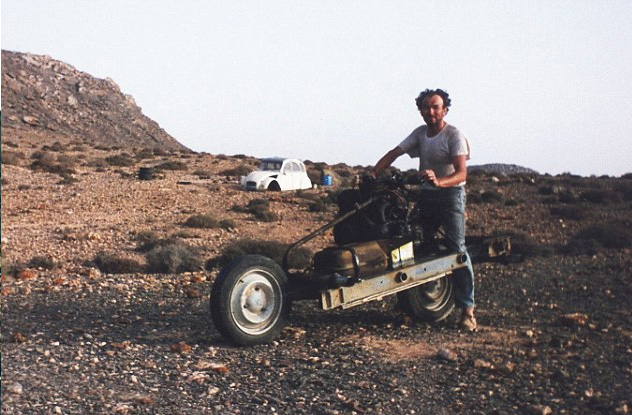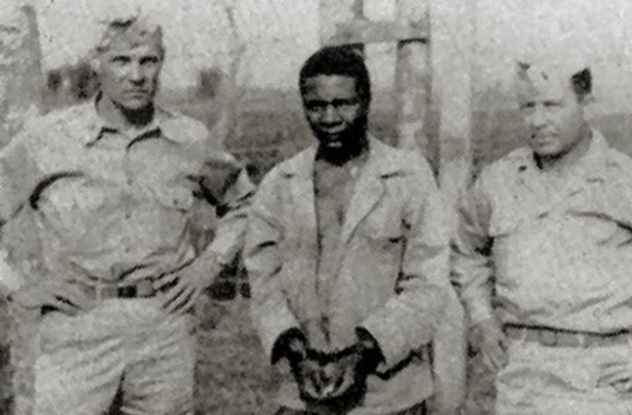 Technology
Technology  Technology
Technology  Humans
Humans 10 Everyday Human Behaviors That Are Actually Survival Instincts
 Animals
Animals 10 Animals That Humiliated and Harmed Historical Leaders
 History
History 10 Most Influential Protests in Modern History
 Creepy
Creepy 10 More Representations of Death from Myth, Legend, and Folktale
 Technology
Technology 10 Scientific Breakthroughs of 2025 That’ll Change Everything
 Our World
Our World 10 Ways Icelandic Culture Makes Other Countries Look Boring
 Misconceptions
Misconceptions 10 Common Misconceptions About the Victorian Era
 Mysteries
Mysteries 10 Strange Unexplained Mysteries of 2025
 Miscellaneous
Miscellaneous 10 of History’s Most Bell-Ringing Finishing Moves
 Technology
Technology Top 10 Everyday Tech Buzzwords That Hide a Darker Past
 Humans
Humans 10 Everyday Human Behaviors That Are Actually Survival Instincts
 Animals
Animals 10 Animals That Humiliated and Harmed Historical Leaders
Who's Behind Listverse?

Jamie Frater
Head Editor
Jamie founded Listverse due to an insatiable desire to share fascinating, obscure, and bizarre facts. He has been a guest speaker on numerous national radio and television stations and is a five time published author.
More About Us History
History 10 Most Influential Protests in Modern History
 Creepy
Creepy 10 More Representations of Death from Myth, Legend, and Folktale
 Technology
Technology 10 Scientific Breakthroughs of 2025 That’ll Change Everything
 Our World
Our World 10 Ways Icelandic Culture Makes Other Countries Look Boring
 Misconceptions
Misconceptions 10 Common Misconceptions About the Victorian Era
 Mysteries
Mysteries 10 Strange Unexplained Mysteries of 2025
 Miscellaneous
Miscellaneous 10 of History’s Most Bell-Ringing Finishing Moves
10 Epic Tales Of Survival Against All Odds
To be trapped in an impossible situation, alone at the mercy of nature, cut off from human company and society—it’s a primal fear, born out of a sense that we would be helpless without the protection of civilization. The truth is that none of us really know how we would respond to such a situation. But, as it turns out, the human spirit can be a surprisingly tough thing.
10Robert McLaren Removed His Own Appendix In The Jungle

By 1942, Robert “Jock” McLaren had already escaped from a prison camp in Singapore, fought for weeks with local guerrillas, been betrayed to the Japanese by a double-crossing comrade, and been interned in a high-security prison camp in Borneo. Books have been written about less. But McLaren was just getting started.
McLaren had been a teenage cavalryman during the First World War, before immigrating to Australia and settling down to a quiet life in Queensland. When the Second World War broke out, the middle-aged veterinarian was one of the first to sign up. Captured by the Japanese after the Fall of Malaya, McLaren staged his first breakout from Singapore’s notorious Changi prison. His recapture didn’t dent his determination to escape. The move to Borneo just meant he was that much closer to home. He quickly teamed up with someone as determined to escape as he was—a local Chinese man known as Johnny Funk, who had been brutally tortured by the Japanese.
Together, Jock and Johnny broke out of prison and trekked to the coast. They then island-hopped for 430 kilometers (270 mi) across the Pacific in a hollowed-out log, fighting running battles with the Japanese along the way, before landing safely on the Philippine island of Mindanao. Unfortunately, the island had already fallen to the Japanese. And McLaren had developed appendicitis.
Hunted by the Japanese and with no way to reach a doctor, McLaren had to make a desperate decision. He had a mirror, a sharp pocketknife, some jungle fibers to stitch the wound, and absolutely no anesthetic. He was going to have to take the appendix out himself.
The operation took four and a half hours. Years later, when receiving the Military Cross, McLaren was asked about the operation. His answer was predictably laconic. “It was hell,” he said, “but I came through all right.”
Two days after the surgery, McLaren was on his feet fleeing the Japanese again. He spent the rest of the war as a guerrilla in the Philippines, most of it in command of an old whaling boat called The Bastard. He packed the boat full of mortars and machine guns and used it to sail into heavily guarded Japanese ports, spray bullets everywhere, and then run for it before anyone could work out what was going on. Despite a huge reward, he was never caught, possibly because everyone was terrified of the notorious rebel leader known to leave severed appendixes in his wake.
9Doug Scott Crawled Down A Mountain On Broken Legs

As one of the true legends of mountaineering, Doug Scott has turned surviving impossible conditions into an art form. In 1975, for example, he and a colleague, Dougal Haston, became the first men to spend the night below the summit of Mount Everest. Unfortunately, they did this by accident, after their climb to the peak took longer than expected. As a result, they had no tent or oxygen and only fairly light clothing. At night the temperature dropped to – 30 degrees Celsius (–22 °F). Scott and Haston survived by digging a hole in the snow for shelter. They didn’t even get frostbite.
But even that pales in comparison to Scott’s incredible descent of Baintha Brakk, a notorious Pakistani mountain known as “the Ogre.” In 1977, almost 25 years after the first conquest of Everest, nobody had ever been able to reach the Ogre’s rocky summit. Scott was determined that he would be the first. The expedition he led was so cash-strapped that it had to hire physically disabled porters. Nonetheless, on July 13, Scott and his climbing partner, Chris Bonington, scaled the 250-meter (820 ft) pinnacle of rock that stood at the Ogre’s peak.
Since it was already late, they decided to speed up their descent by abseiling back down the rock face. This was not a good decision. As he tried to rappel down, a sudden gust of wind swung Scott violently into the cliff, shattering both his legs. Since only his lower legs were broken, Scott managed to abseil the rest of the way down using his knees to push off from the rock.
Fortunately, the pair was soon joined by two other members of the expedition. Unfortunately, they were still over 2,000 meters (6,500 ft) from their base camp. And then a blizzard forced them to shelter in a cave for two days, where they ate the last of their rations. Since the rough terrain made it impossible for the other climbers to carry Scott (especially after Bonington broke two of his ribs in a separate fall), he know there was only one path to survival—he was going to have to crawl down the mountain.
He crawled for seven days, on his hands and knees, down one of the highest mountains in the world. By the end, he had worn through four layers of clothes, and his knees were a bloody pulp. He did it all with two untreated broken legs and on starvation rations, and he still moved so fast that he sometimes ended up ahead of the other three.
When the four climbers reached the site of their base camp, they found it empty—they had been gone for so long that their support team had assumed they were dead. Scott was eventually flown off for emergency medical treatment. The helicopter crashed at the hospital, but it shouldn’t surprise anyone to learn that he crawled away without a scratch.
8Gareth Wood Fought A Seal In Antarctica

In 1984, Gareth Wood, Robert Swan, and Roger Mear set off to walk to the South Pole. Their journey was soon dubbed the “Footsteps of Scott Expedition” since it aimed to retrace the famous journey to the pole of Robert Falcon Scott. Given that Scott’s entire party famously died of starvation, exhaustion, and cold on the way back from the Pole, this seemed something of an odd decision. Furthermore, only two previous expeditions had reached the Pole overland—Scott and his great rival Roald Amundsen. To succeed, Wood’s team would have to make the longest unsupported trek in history.
Surprisingly, the journey largely went off without a hitch—until it was time to go home, when the support ship Southern Quest was crushed by ice and sank before it could reach the expedition. The crew had to be rescued from nearby ice floes. Meanwhile, Wood was far away, hiking across the frozen Backdoor Bay. The ice was thin in places, so Wood moved carefully, testing the surface one foot at a time. Then, as he made his way over the frigid depths, something huge came up through the ice.
Wood later described the surface “exploding” as a fully grown leopard seal burst through the thin ice and clamped its teeth around Wood’s leg, slicing through the thick polar gear and into his flesh. The seal then tried to drag Wood back through the hole in the ice and into the freezing water—a death sentence in more ways than one. Only a crampon secured to the ice stood between the explorer and death. Somehow, he managed to struggle with the creature until his companions arrived and began kicking the seal in the head. Still, it refused to release its grip on Wood, until, defeated, it finally sank back beneath the ice. Wood’s relieved companions pulled him back from the edge.
Then the seal leaped through the ice again, sank its teeth into the same leg as before, and the whole thing began anew.
Wood could count himself lucky that he did eventually escape. In 2003, a leopard seal dragged a British biologist underwater to her death, the first recorded case of a seal killing a human.
7A British Climber Swam Through An Avalanche

Early in 2013, three amateur British climbers were enjoying the trip of a lifetime as they scaled the famous Mont Blanc in the Italian Alps. Mont Blanc is famous for its frequent avalanches, which make the mountain one of the deadliest in the world—as many as 100 climbers and hikers die on it each year. And as the three Britons descended the peak known as the Aiguille di Bionnassay, they heard the telltale rumble of oncoming doom.
Two of the climbers, Misha Gopaul and Ben Tibbetts, were just able to get to safety. But the third climber, who asked that his name not be released to the media, was hit full-force by a crushing wave of snow and ice. Desperate to avoid being buried, the climber did the only thing he could think of to escape certain death—he swam.
For over 700 meters (2,300 ft) he swam with the avalanche as it carried him down the mountainside. Of course, it’s not technically possible to swim in snow, but the wide, circular motions kept him near the surface. When the avalanche petered out, he was close enough to the top that he was able to pull himself out of the snow and walk to safety.
He swam through an avalanche and walked away without a scratch, and he didn’t even want the world to know his name afterward.
6A Stranded Emile Leray Built A Motorcycle Out Of His Car

In 1993, French adventurer Emile Leray was driving through the Sahara in his Citroen 2CV car when he was stopped by a military roadblock. The soldiers told Leray of fighting in the area and refused to let him continue down the road. The type of person who decides to drive through the Sahara in an economy car usually isn’t very good at assessing danger, and Leray decided to press on anyway.
To get around the roadblock, he simply left the road, driving through the desert itself with the intention of rejoining the trail where the soldiers couldn’t see him. The plan might actually have worked—if the Citroen hadn’t hit a rock, shattering its frame and turning the car into a useless lump of metal. Alone in the middle of the desert with no transport and no way to call for help, Leray seemed doomed.
But Leray realized that his engine still worked. If he couldn’t use it to power the Citroen, the former electrician would just have to build something it could power. And so, in true Flight of the Phoenix style, Emile Leray decided to build a motorcycle out the wreck of his car.
If anything, it was even harder than it sounds. Leray only had a basic automobile-repair toolkit and a hacksaw. Racing against time and with his supplies dwindling, he began disassembling the Citroen and hammering the parts into a crude motorcycle frame. It took him 12 days of constant labor in the heat of the Sahara—that’s 12 days of desperate fear, uncertainty, and thirst—but at the end of it, Emile Leray rode out of that desert on a bike he had built himself. Eat your heart out, MacGyver.
5Davey Du Plessis Escaped A Mugging (On The Amazon)
In 2012, 24-year-old South African Davey du Plessis set out on a six-month journey up the Amazon. His goal was to become the youngest person to travel solo along the entire river from source to sea. Du Plessis knew it could be a dangerous journey—for one thing, he had never paddled a folding kayak before—but the first three months went fairly well. Du Plessis biked 800 kilometers (500 mi) along the riverbank and paddled his kayak another 1,100 km (700 mi).
On August 25, du Plessis was paddling down a murky stretch of the river, excited since he had just seen his first manatee. River dolphins frolicked alongside the kayak, and du Plessis made a note of two new species of birds singing in the trees. At one point, he passed two men in a motorized canoe, but he didn’t think too much of it. Such encounters were not uncommon on the river. A few minutes later, he felt a thump in his back, a stinging pain, and then he was underwater. When he tried to swim to the surface, he found that his arms wouldn’t work.
Desperate for air, he used his legs to swim, but as soon as his head cleared the water, something slammed into his face. Dazed, he managed to push himself to the riverbank, where he sat down and cradled his head. Not till the third bullet hit did he realize someone was shooting at him.
Somehow, du Plessis found the strength to start running. He ran for 5 kilometers (3 mi), zigzagging through the jungle until he was safe. Then he walked even farther, heading deep downriver in the hope of finding help. All of his possessions had been lost with the kayak.
When he finally stumbled across two locals, he was too weak to even whistle to attract their attention. A shotgun pellet had punctured his heart, and others had hit his lungs. His carotid artery had been almost completely severed, and he came close to choking to death on his own blood.
The impoverished locals couldn’t afford to take him all the way to the nearest town, so he was passed from village to village, stubbornly clinging to life for days. When he finally did reach a hospital, the doctors refused to treat him until his family confirmed they could pay. But du Plessis said the kindness of the locals he encountered deep in the Amazon gave him the strength to stay alive and make a full recovery.
4Peter Trayhurn Is The Unluckiest And Luckiest Man Alive

In 2006, Peter Trayhurn and his dive partner Geoff Tosio took a boat out to Pimpernel Rock. The jagged underwater spire is cut through with winding tunnels and home to huge shoals of yellowfish and red morwong—and dozens of gigantic gray nurse sharks. Trayhurn was a keen underwater photographer, and he spent the day capturing shots of the breathtaking underwater landscape. When he surfaced for the last time, the boat was gone. The two men were left stranded, treading water in the middle of the empty ocean.
The boat’s anchor chain had snapped, causing it to drift away while Trayhurn and Tosio were underwater. The two men spent four hours trying to stay afloat, holding on to each other to stay together as the current pulled them farther out to sea. To pass the time, Trayhurn took pictures of their situation.
As the ocean grew rougher, a miracle happened. Against all odds, a passing tanker spotted the two men and radioed the police, who sent a boat to retrieve the divers. It seemed like their ordeal was over—until the police boat capsized in the rough conditions, throwing the pair right back into the ocean.
This time, Trayhurn lost his camera in the struggle to stay afloat. Luckily, he and Tosio, along with the police crew, were rescued a second time and made it safely back to dry land.
Having been lost at sea and rescued twice in one day, Trayhurn presumably thought he’d used up all his luck. Then, four years later, a man walking his dog along the beach found a mysterious object lying in the sand. It was Trayhurn’s camera, battered but unharmed after four years exposed to the elements. His pictures came out fine.
3The American Nurses Who Crossed The Balkans Behind Enemy Lines

In November 1943, a group of 12 American nurses boarded a transport plane in Sicily. They were scheduled for a short flight to southern Italy, where they would resume caring for injured American soldiers fighting in the area. Instead, the plane was attacked by German fighters and blown off course into a terrifying storm. The pilot was forced to crash land in uncertain territory. The 30 survivors, including the nurses, were shocked to realize that they were hundreds of miles off course, in the heart of Nazi-occupied Albania.
The crew fled the plane, aware that the Nazis would be racing to the site to take them prisoner. As female non-combatants, the nurses could have surrendered and expected comparatively good treatment. But they were made of sterner stuff than that. They instead embarked on one of the most harrowing treks behind enemy lines in history, sheltering with local resistance fighters as they made their way to the coast, where they hoped to make contact with the Allies.
Their journey took them almost 1,300 kilometers (800 mi) through hostile terrain, often barely keeping ahead of the Nazis and fascist Albanian forces. They climbed over a 2,400-meter (8,000 ft) mountain in the middle of a brutal blizzard, survived being strafed by the Luftwaffe, and escaped a rebellious town moments before German forces leveled it The group eventually made contact with British Intelligence and arranged to be evacuated by sea. Of the 30 who survived the plane crash, all made it out safely, a truly amazing feat of survival.
2The Jungle King

During World War II, Herman Perry was part of a US Army labor battalion in Burma. The entirely African-American battalion (except the officers, who were white) spent 16 hours a day breaking rocks in the blazing sun while dealing with disease, monsoons, leeches, and tiger attacks. And when tiger attacks are the least of your problems, you know things are bad.
In a truly cruel twist, the road they were building was completely pointless. It was supposed to allow the resupply of Chinese forces fighting the Japanese, but everyone from Winston Churchill down knew that the war would be over long before it was completed. The Allies built it anyway as a gesture to the Chinese. Approximately two men died per mile of road.
Perry had already spent three months in the local military prison after talking back to a superior. The prison was a truly horrifying place known for punishing prisoners in a windowless metal-roofed cell called “the sweat-box.” So when Perry heard he was going to be sent back for malingering, he snapped. With tears in his eyes, he shot an officer trying to arrest him, and he ran.
Amazingly Perry didn’t meet his death in the impenetrable wilderness. Instead, he flourished, being adopted into a feared local tribe of headhunters and marrying the chief’s daughter. With the chief’s support, he set himself up as a successful hunter and ganja farmer. As word of his survival seeped out, he became a legend among US troops in the region, who began referring to him as “the Jungle King.”
Meanwhile, the American authorities were determined to take Perry down. A raid hit the headhunter village, and “the Jungle King” was shot, captured, and sentenced to death. Shortly before the sentence was due to be carried out, he escaped by crawling Shawshank-style through a prison drainage ditch. Two weeks later, he was surrounded and shot but sprinted through a hail of bullets and floated downriver on a log while his pursuers watched helplessly.
The military then lured him into an ambush, during which he was shot three times but escaped yet again. He was finally captured days later, while disguised as a local. He was sent to the gallows the very next day, surrounded by 17 armed military policemen—with orders to kill him immediately, even before defending themselves, if any confrontation broke out.
1James Scott Survived For 43 Days On Two Chocolate Bars And A Caterpillar

In 1991, Australian medical student James Scott was volunteering at a hospital in Nepal. In his spare time, James developed a love of trekking through the Himalayas. Shortly before Christmas, he was heading toward the popular Helambu Trail when he encountered a party of Germans who told him about another, hidden path. The new trail, the Germans assured him, was far more scenic than the overrated Helambu, and it only took a few hours to walk. They even offered to give him their map. But before they left, the Germans gave James a warning: “If it snows, you must turn back.”
As James and two companions set out on the trail, they were greeted with a light dusting of snow. James remembered the Germans’ warning, but the snow was so light that there hardly seemed any risk. He resolved to press on, although one of his companions complained his knees were giving out and had to turn back. Somehow, none of them realized that the man who had turned back had been carrying the map as well as the group’s only lighter.
They climbed farther along the trail, and the snow grew thicker. Soon, it was so heavy that visibility was almost zero. Alarmed, James decided to turn back, but his remaining fellow traveler decided to press on. Before long, James was completely lost. He spent the night under a small rock overhang.
When he awoke, he found himself near a small creek, surrounded by virtually impassible mountains. He had two chocolate bars, a small notebook, and a copy of Great Expectations. He had no compass, map, or way to start a fire. His clothes included a light ski jacket and tennis shoes. It was certain death.
He ate the chocolate bars sparingly over the first few days, a quarter at a time, trying to make them last as he searched for a trail. Once they ran out, James had no food at all, except for a caterpillar which he found crawling across the rocky ground. He didn’t find another. For water, he ate snow, which also helped with the hunger pangs. He had to force himself to eat only enough snow to avoid dehydration, since every mouthful risked dangerously lowering his body temperature.
Once, he saw a great black bear, but by that point, he was too weak to do anything but stare as it wandered away. His only advantage was that his love of karate had left him with thick muscles around his legs and back. As his body began to eat itself, these muscles withered away.
Meanwhile, James’s sister Joanne had flown to Kathmandu to coordinate the rescue effort. Experienced climbers fanned out across the mountains and posters of James were widely distributed, promising a reward for whoever found him. The trackers Joanne hired assured her that there was no need to check the southwestern region. There was no way James could have made it down there, they claimed—the route was completely impassable. In desperation, she decided to visit a famous lama. To her surprise, the holy man assured her that James would be found. Asking to see her map, he pointed to the southwest region.
It took 43 days before James was found. For 43 days he ate nothing but snow, two chocolate bars, and a caterpillar. When he heard the helicopter overhead he was almost too weak to crawl out and wave to it. Almost, but not quite.
Alex locked himself out of his flat once. It was terrible.








